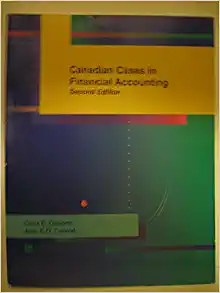Please answer the following questions, Thanks!
Q1
For each of the following situations, identify the appropriate method of revenue recognition and the amount of gross profit to be recognized in 2001. a. A company entered into a contract to construct a building for a fee of $650,000. Construction began in 2001 and will be completed in 2003. Estimated cost of the project is $450,000. During 2001 costs of $180,000 were incurred. All costs and revenues can be reasonably estimated. b. A company sold goods for $100,000 during 2001. Of this amount, $60,000 was cash and $40,000 was on account. The company collected $20,000 of the sales on account during 2001 . The cost of the goods sold was $70,000. c. Assume the same facts as in (a) except that costs are unable to be estimated with any degree of reliability. d. The following data relates to a rm that allows payments to be made over an extended period of time. Ultimate collection of the sales revenue is not reasonably estimable. Total credit sales for the year $100,000 Gross prot percentage 40% Collections on account $60,000 1. Laura and Sally are partners who share profits 60% and 40%. Their capital balances were both $60,000 before Karen was admitted to the partnership. Karen paid $70,000 each to Laura and Sally for purchase of a 25% interest in the partnership. After her admission to the partnership, Karen will have a capital balance of $ 2 . Jim and Mary are partners who share profits 60% and 40%. Their capital balances were both $60,000 before Betty was admitted to the partnership. Betty contributed $100,000 in cash to the partnership for a 30% interest. After Betty is admitted to the partnership, Jim will have a capital balance of $_ 3. Jerry and Sundar are partners who share profits 40% and 60%. Before Bill was admitted to the partnership, Jerry's and Sundar's capital balances were $85,000 and $60,000, respectively. Bill contributed $95,000 in cash to the partnership for a one-half interest. After Bill is admitted to the partnership, Sundar will have a capital balance of $ 4. Rick, Sam, and Yeshiv are partners who share profits 50%, 25%, and 25%. Their capital balances were $78,000, $52,000, and $30,000, respectively, before Yeshiv's retirement. Rick and Sam each paid Yeshiv $20,000 from their personal assets to buy half his interest. After Yeshiv has withdrawn, Rick will have a capital balance of $ 5. Matt, Nick, and Scott are partners who share profits 30%, 30%, and 40%. Their capital balances were $105,000, $70,000, and $35,000, respectively, before Scott's retirement. Scott was paid $55,000 from partnership assets to buy his interest. After Scott has withdrawn, Matt will have a capital balance of $ 6. Gina, Jane, and Ping are partners who share profits 40%, 20%, and 40%. Their capital balances were $35,000, $15,000, and $10,000, respectively, before Ping's retirement. Ping was paid $7,000 from partnership assets to buy her interest. After Ping has withdrawn, Gina will have a capital balance of $








